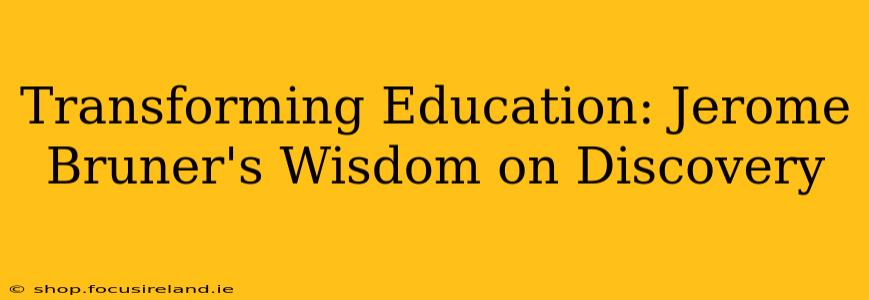Jerome Bruner, a towering figure in cognitive psychology and educational theory, profoundly impacted how we understand learning and teaching. His emphasis on discovery learning, a student-centered approach that prioritizes active learning and problem-solving, continues to resonate deeply in modern educational reform efforts. This exploration delves into Bruner's key ideas and their enduring relevance in transforming education today.
What is Discovery Learning According to Bruner?
Bruner's concept of discovery learning isn't about students stumbling upon knowledge accidentally. Instead, it's a structured process guided by the educator. It emphasizes the importance of active participation and intellectual autonomy. Students aren't passively absorbing information; they're constructing their understanding through exploration, experimentation, and problem-solving. The teacher acts as a facilitator, providing the necessary scaffolding and resources to support the student's journey of discovery. The focus is on the process of learning, not just the end product. This process fosters critical thinking, creativity, and a deeper understanding of the subject matter.
How Does Discovery Learning Differ from Traditional Teaching Methods?
Traditional teaching methods often rely on didactic lectures and rote memorization. Information is presented to students, who are expected to passively absorb and regurgitate it. In contrast, discovery learning flips this script. It prioritizes student engagement through inquiry-based learning, hands-on activities, and collaborative projects. Instead of simply receiving facts, students actively participate in constructing their understanding, fostering a more profound and lasting impact. This difference is crucial because it shifts the power dynamic in the classroom, empowering students to take ownership of their learning.
What are the Key Principles of Bruner's Theory of Instruction?
Bruner's theory isn't just about discovery learning; it encompasses several interconnected principles that contribute to effective instruction:
- Structure: Learning should be organized around fundamental structures or underlying principles, allowing students to build upon their knowledge in a meaningful way.
- Readiness: Instruction should be tailored to the student's developmental stage and prior knowledge. Bruner believed that any subject could be taught effectively to any child at any age, provided it is done in a way that is appropriate for their developmental level.
- Intuitive and Analytic Thinking: Bruner emphasized the interplay between intuitive (holistic and immediate) and analytic (systematic and logical) thinking. Effective instruction should foster both.
- Motivation: Intrinsic motivation is crucial for effective learning. Discovery learning, by its very nature, is inherently engaging and motivating for many students.
What are the Benefits of Discovery Learning in the Classroom?
Implementing Bruner's principles can yield numerous benefits:
- Increased Engagement and Motivation: Students are more actively involved in the learning process, leading to greater engagement and a stronger sense of ownership.
- Deeper Understanding: Active participation allows students to develop a more profound understanding of concepts and principles.
- Enhanced Problem-Solving Skills: Discovery learning encourages students to develop their critical thinking and problem-solving skills through exploration and experimentation.
- Improved Creativity and Innovation: The freedom to explore and experiment fosters creativity and innovation.
- Greater Retention: Knowledge acquired through active participation is often retained more effectively than passively received information.
What are Some Examples of Discovery Learning Activities?
Discovery learning can manifest in various ways:
- Science Experiments: Students design and conduct experiments to test hypotheses and draw conclusions.
- Case Studies: Analyzing real-world scenarios to understand complex issues and develop problem-solving strategies.
- Collaborative Projects: Working in groups to research, analyze, and present information on a specific topic.
- Problem-Based Learning: Students work together to solve real-world problems, applying their knowledge and skills.
Is Discovery Learning Suitable for All Subjects and Students?
While discovery learning offers significant advantages, it's not a one-size-fits-all solution. Some subjects might lend themselves more readily to this approach than others. Similarly, some students might require more structured guidance than others. Effective implementation requires careful planning and adaptation to the specific context, including the subject matter, student needs, and available resources. The key lies in finding the right balance between guided exploration and direct instruction.
How Can Teachers Implement Discovery Learning in Their Classrooms?
Implementing discovery learning effectively requires a shift in teaching philosophy. Teachers must transition from the role of the sole source of information to that of a facilitator and guide. This might involve:
- Creating a supportive and collaborative learning environment: Encourage student interaction, collaboration, and peer learning.
- Providing appropriate scaffolding: Offer support and guidance without explicitly providing all the answers.
- Using open-ended questions: Encourage students to explore and investigate their own ideas.
- Providing opportunities for feedback and reflection: Encourage students to reflect on their learning process and identify areas for improvement.
Jerome Bruner's legacy extends far beyond his specific theories. His emphasis on student-centered learning, active engagement, and the construction of knowledge remains profoundly relevant in today's educational landscape. By embracing his insights, educators can empower students to become active learners, critical thinkers, and creative problem-solvers, ultimately transforming education for the better.

